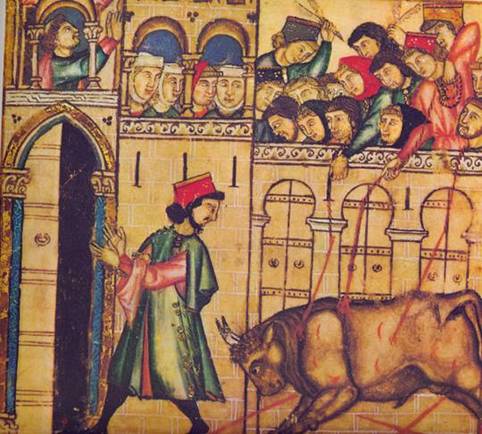|
Saint Florentina
Florentina of Cartagena (died ca. 612) is venerated as a saint by the Catholic Church. Born towards the middle of the sixth century in Cartagena, Hispania, she and her family were actively engaged in furthering the best interests of Christianity. Florentina was the sister of three Iberian bishops in the time of the Visigothic dominion (Leander, Isidore of Seville, and Fulgentius). She was younger than her brother Leander, later Archbishop of Seville, but older than Isidore, who succeeded Leander as archbishop of the same see. All four have been canonized by the Catholic Church. Losing their parents at an early age, she was placed under the guardianship of her brother, Leander, who had since taken monastic vows, and it was through his influence that Florentina embraced the ascetic life. She associated with herself a number of virgins, who also desired to forsake the world, and formed them into a religious community. Later sources declare their residence to have been the convent o ... [...More Info...] [...Related Items...] OR: [Wikipedia] [Google] [Baidu] |
Catholic Church
The Catholic Church, also known as the Roman Catholic Church, is the largest Christian church, with 1.3 billion baptized Catholics worldwide . It is among the world's oldest and largest international institutions, and has played a prominent role in the history and development of Western civilization. O'Collins, p. v (preface). The church consists of 24 ''sui iuris'' churches, including the Latin Church and 23 Eastern Catholic Churches, which comprise almost 3,500 dioceses and eparchies located around the world. The pope, who is the bishop of Rome, is the chief pastor of the church. The bishopric of Rome, known as the Holy See, is the central governing authority of the church. The administrative body of the Holy See, the Roman Curia, has its principal offices in Vatican City, a small enclave of the Italian city of Rome, of which the pope is head of state. The core beliefs of Catholicism are found in the Nicene Creed. The Catholic Church teaches that it ... [...More Info...] [...Related Items...] OR: [Wikipedia] [Google] [Baidu] |
Plasencia
Plasencia () is a walled market city in the province of Cáceres, Extremadura, Western Spain. , it has a population of 41,047. Situated on the bank of the Jerte River, Plasencia has a historic quarter that is a consequence of the city's strategic location along the Silver Route, or ''Ruta de la Plata''. Since the 15th century, the noblemen of the region began to move to Plasencia, defining its current appearance. History Antiquity and the Middle Ages Although Plasencia was not founded until 1186, pieces of pottery found in ''Boquique’s Cave'' provide evidence that this territory was inhabited long before. Pascual Madoz's dictionary details that this ancient territory, either called ''Ambroz'' or ''Ambracia'', was originally given the name '' Ambrosia'' before becoming Plasencia. In the same year that the city was founded, Alfonso VIII of Castile gave the city its independence and the Diocese of Plasencia was created. The original motto of the city, ', means ''to please Go ... [...More Info...] [...Related Items...] OR: [Wikipedia] [Google] [Baidu] |
6th-century Women
The 6th century is the period from 501 through 600 in line with the Julian calendar. In the West, the century marks the end of Classical Antiquity and the beginning of the Middle Ages. The collapse of the Western Roman Empire late in the previous century left Europe fractured into many small Germanic kingdoms competing fiercely for land and wealth. From the upheaval the Franks rose to prominence and carved out a sizeable domain covering much of modern France and Germany. Meanwhile, the surviving Eastern Roman Empire began to expand under Emperor Justinian, who recaptured North Africa from the Vandals and attempted fully to recover Italy as well, in the hope of reinstating Roman control over the lands once ruled by the Western Roman Empire. In its second Golden Age, the Sassanid Empire reached the peak of its power under Khosrau I in the 6th century.Roberts, J: "History of the World.". Penguin, 1994. The classical Gupta Empire of Northern India, largely overrun by the Huna, ended i ... [...More Info...] [...Related Items...] OR: [Wikipedia] [Google] [Baidu] |
7th-century Women
The 7th century is the period from 601 (DCI) through 700 ( DCC) in accordance with the Julian calendar in the Common Era. The spread of Islam and the Muslim conquests began with the unification of Arabia by Muhammad starting in 622. After Muhammad's death in 632, Islam expanded beyond the Arabian Peninsula under the Rashidun Caliphate (632–661) and the Umayyad Caliphate (661–750). The Muslim conquest of Persia in the 7th century led to the downfall of the Sasanian Empire. Also conquered during the 7th century were Syria, Palestine, Armenia, Egypt, and North Africa. The Byzantine Empire suffered setbacks during the rapid expansion of the Caliphate, a mass incursion of Slavs in the Balkans which reduced its territorial limits. The decisive victory at the Siege of Constantinople in the 670s led the empire to retain Asia Minor which assured the existence of the empire. In the Iberian Peninsula, the 7th century was known as the ''Siglo de Concilios'' (century of councils) r ... [...More Info...] [...Related Items...] OR: [Wikipedia] [Google] [Baidu] |
.jpg)


